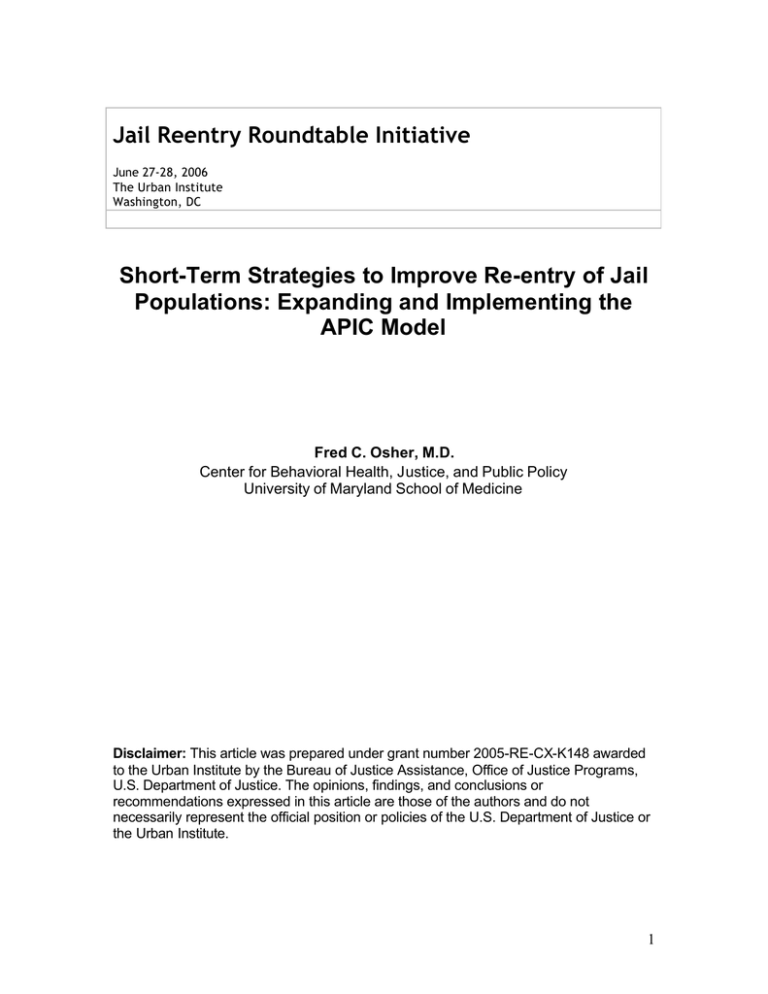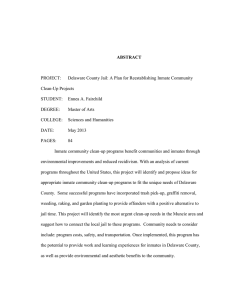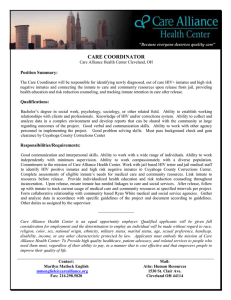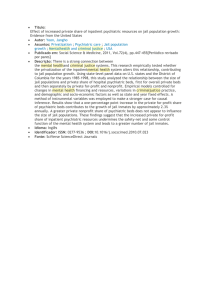Jail Reentry Roundtable Initiative Short-Term Strategies to Improve Re-entry of Jail
advertisement

Jail Reentry Roundtable Initiative June 27-28, 2006 The Urban Institute Washington, DC Short-Term Strategies to Improve Re-entry of Jail Populations: Expanding and Implementing the APIC Model Fred C. Osher, M.D. Center for Behavioral Health, Justice, and Public Policy University of Maryland School of Medicine Disclaimer: This article was prepared under grant number 2005-RE-CX-K148 awarded to the Urban Institute by the Bureau of Justice Assistance, Office of Justice Programs, U.S. Department of Justice. The opinions, findings, and conclusions or recommendations expressed in this article are those of the authors and do not necessarily represent the official position or policies of the U.S. Department of Justice or the Urban Institute. 1 Abstract Almost all jail inmates will leave correctional settings and return to the community. Inadequate transition planning puts jail inmates, who entered the jail in a state of crisis, back on the streets in the middle of the same crisis. The outcomes of inadequate transition planning include the compromise of public safety, increased disability secondary to health and behavioral health symptoms, hospitalization, suicide, homelessness, new criminal offenses, and re-arrest. With the majority of inmates being released within a very short period of time, often without notice, jails present unique challenges to transition planning. While there are currently no outcomes studies to guide evidence-based jail transition planning practices, there is enough guidance from the multi-site studies of the organization of jail health programs to create a best practice model. This manuscript presents one such model that was derived from efforts to address offenders with mental illnesses, but has applicability to the general inmate population. The APIC model – Assess, Plan, Identify, and Coordinate - describes elements of re-entry associated with successful integration back into community. Experience with this model will be reviewed. The focus of this mono graph will be on the process of transition planning rather then specific measurement and assessment tools, with the principle aim to improve linkage of inmates released from custody to the community-based services that can support their community tenure. 2 Introduction: The rates of arrest and incarceration in the United States continue to grow (Harrison & Beck, 2005) and the vast majority of these arrests end in inmate release to liberty on the street. More than seven million unique individuals will be released from jails and prisons annually, mostly from local and county jails (Hammett, Roberts, & Kennedy 2001). In addition to the primary responsibility of segregating these individuals from society, jails are important community institutions with significant relationships to public health and social welfare systems. Taking an individual into custody provides an opportunity to identify the health and social needs of arrestees during the process of incarceration. The information collected can be used to impact inmate transition from jail and individual and community health and safety outcomes. Inadequate transition planning can put individuals who entered jail in a crisis state, back on the street in the middle of the same crisis. This in turn is associated with compromised community safety, homelessness, exacerbated health problems, behavioral disturbances, probation and parole revocations, new crimes, and re-arrest. While jails have a constitutional obligation to provide minimal standards of care, what this standard is as it relates to preparation for release is poorly defined. In the narrowest sense, correctional responsibility ends at the moment of release. This viewpoint separates jail services from their broader community context and ignores the revolving door patterns of so many inmates. Yet, jails face unique challenges when accepting a broader role in preparing inmates for community reintegration. Unlike prisons with long term sentenced individuals, the jail population consists of detained pre- 3 trial individuals who await their court appearance, inmates who are sentenced and await transfer to a prison, convicted individuals serving short-term sentences, typically less than one years’ duration, and probation, parole, and bail-bond violators. Short episodes (less than 72 hours) of detention are commonplace for the majority of jail inmates and release from jail is often unpredictable making transition planning particularly challenging (Griffen, 1990). And even while acknowledging the importance or release planning, jails routinely report that very little release planning takes place (Steadman and Veysey, 1997; Wolff et al, 2002). The central mission of jails remains segregation, yet the time spent during jail processing represents a significant public health opportunity (Glaser JB & Greifinger RB., 1993, Potter & Rapposelli, 2002). In absolute and relative terms, large numbers of U.S. citizens with infectious diseases, mental and addictive disorders, and a wide range of acute and chronic medical conditions will have contact with the criminal justice system. It is estimated that one quarter of all people living with HIV in the U.S. pass through a prison or jail in a given year, one third of all people with Hepatitis C infection, and 40 percent of all people with TB (Hammett, Harmon and Rhodes, 2002). The Bureau of Justice Statistics reports that almost a third of state inmates report having a physical or mental health problem (Maruschak & Beck, 2001). Inmates that are not connected to services that will assist their reintegration into communities, especially if they have significant health problems, are more likely to return to jail. Jail size 4 In addition to the constant churning of arrestees through jail and court processes, jail size is another critical feature in the development of systemic approaches to release. What is necessary and practical in large urban mega-jails averaging over 100,000 bookings each year may not be feasible in small rural jails with less than 500 bookings, or even mid-size jails with fewer than 10,000 bookings. The model of transition planning presented in this monograph is to serve as guidance rather than a recipe, and requires the context of a specific jail be considered in tailoring the approach. Whatever re-entry approach a jail takes must be balanced between the resources available for transition planning, the needs of inmates, and the availability of community resources. Language Throughout this article, we follow the suggestion of the American Association of Community Psychiatrists (2000) by using the term “transition planning,” rather than “discharge planning” or “re-entry planning” (AACP, 2001). The AACP recommends “transition planning” as the preferred term because transition both implies bi-directional responsibilities and requires collaboration among providers. It is understood that some ex-offenders will return to custody and as such re-entry can be seen as part of a cycle of care. Transition planning is also discussed as a process and not an event. The gathering of information and linkage to community systems of support begins at booking, continues throughout the jail stay, and requires post-release monitoring to allow for quality improvement. Making it happen at the System Level – The importance of collaboration 5 Efforts in the past to help people in the criminal justice system reintegrate into productive social roles within their community have highlighted that positive outcomes can only be achieved through meaningful corrections-community collaborations. Historically, navigating the jail-community boundary has been challenged by corrections’ resistance to involve outside agencies in their facility programming, and community-based providers’ reluctance to work with persons with histories of criminal justice involvement. In order to mobilize a transition planning system, key personnel on both sides of the fence must believe that a shared response to jail inmates is necessary, and that shared goals and objectives can only be attained when the needs of this population are addressed through collaborative efforts between agencies. A community commitment to the transition process must be affirmed and leadership is required to integrate the many partners associated with successful re-entry activity. A local jail transition coordinating group should be established. Membership should include all relevant stakeholders from corrections and community service agencies including: O jail and prisons, prosecutors, public defenders, drug and relevant specialty courts, juvenile systems, probation and parole boards, and community corrections: and O primary health care, mental health and substance abuse, academic medical centers, HIV prevention and AIDS organizations, social service agencies (housing, employment, child protection, welfare), schools, and faith-based organizations. 6 This jail re-entry coordinating group should define the target population for re-entry initiatives, articulate measurable goals and objectives, outline the range of needs in incoming and returning detainees, and identify the availability of requisite services upon release. Broad goals of the group are typically to reduce disruptive behavior in the community after release, improve the individuals’ physical and social status, and decrease the likelihood that the person will re-offend and reappear in the jail. Barriers to successful re-entry should be identified by this group and solutions proposed. An overarching community plan for re-entry should be established. Following this strategic planning activity, the group should develop a mutually agreed to delineation of roles and responsibilities, and assign responsibility and accountability to appropriate agencies. Jail staff will typically be responsible for screening, assessment, crisis intervention and stabilization, and the initiation of treatment and social service interventions. Court staff will need to develop conditions of release, and coordinate their communications between the jail and the defendant or sentenced inmate. Community providers will need to identify their capacity for timely acceptance of referrals, provide individualized services and supports, and participate in follow- up and monitoring activities. Mechanisms to support this interconnected network include new working agreements between service organizations to coordinate the provision of services, the accurate recording of jail and community-based service provision, management information systems with information shared as permitted by confidentiality requirements, and ongoing staff cross-training activities (GAINS Center, 1999). The jail transition oversight group will have ongoing responsibility to monitor transition activity 7 and expected outcomes, problem solve, evaluate, and reform the transition model based on their collective experience. These systemic activities are required prior to the development of individual transition planning models. An example of a systemic planning process to address the goals of re-entry can be seen in the development of Day Reporting and Re-entry Centers (DRRC) in Broward County Florida (Gulick, 2005). The DRRC was designed to provide offenders leaving the county jail with the support needed to transition successfully through intensive supervision upon release and access to an extensive menu of community services. The DRRC targets split sentence populations (jail followed by probation), misdemeanor repeat violators (diverting these individuals from returning to jail), and a walk-in population of offenders that have completed sentences or been referred by the courts. As a variant of the traditional day reporting center, the DRRC is a model that addresses the overall community re-entry goals while accommodating the unpredictable nature of jail release. Making it Happen at the Individual Level – the APIC Model In an effort to address re-entry from jails of offenders with mental illnesses, the National GAINS Center conducted a series of meeting with jail administrators and reviewed programmatic re-entry efforts around the country. This process resulted in the publication of “A Best Practice Approach to Community Re-entry form Jails for Inmates with Co-occurring Disorders: The APIC Model (Osher, Steadman, & Barr, 2002)”. As depicted in Table 1, the model identifies four sets of tasks that are required in the jail 8 transition process. While originally conceived as specific to inmates with co-occurring mental and addictive disorders, the tasks have been identified as relevant to the entire jail population (CSG, 2004). Each of these tasks will be reviewed and highlighted with program examples. Table 1 APIC Model Assess Assess the inmates clinical and social needs, and public safety risks Plan Plan for the treatment and services required to address the inmate’s needs Identify Identify required community and correctional programs responsible for postrelease services Coordinate Coordinate the transition plan to ensure implementation and avoid gaps in care with community-based services ASSESSMENT As previously stated, incarceration represents a public health opportunity. Inmates may be, but likely have not been, participants in community health and social services, and enter jail facilities with a variety of social, psychological, and medical needs. For some individuals, the history and physical examination in jail may be the most comprehensive assessment they have ever received. Information gathered during the booking process is critical to acute management and longer term programming for inmates. While security issues within jail are paramount, and risk assessments for housing assignment and level 9 of supervision are critical components of early assessment efforts, the APIC model focuses on dimensions immediately relevant to the inmate’s transition back to the community. The moment of release is critical to community integration. Given the unpredictable nature of jail release, the assumption that release is imminent should govern assessment strategies. The goals of the assessment process within jail settings are to: • collect as much relevant information as possible, as early as possible; • use validated screening tools and measures whenever possible; • conduct in-depth assessments on identified areas of need as time permits; • record all collected information in a manner that makes it readily accessible to those who need to know (including inmates) both during incarceration, upon release, and upon possible future re-arrests; • update information that is dynamic (subject to change) at regular intervals; and • re-assess the inmate prior to release. The information required to develop adequate transition plans includes: • basic demographic and historical information; • housing status prior to arrest and options following release; • availability of food, clothing, utilities (heat, phone), and transportation; • family status with particular attention to dependent children; • health care status including probable diagnoses, medication requirements, and existing or potential health care benefits; 10 • mental health (with particular attention to history of trauma and depression) and substance abuse status (including need for detoxification or opiate maintenance therapy); • functional skills including literacy level and problem solving capacity; • income supports, both from employment and government entitleme nt programs; and • legal status (defense counsel, court appearances, community supervision) Screening and assessment of these issues is both critical to jail management and transition planning. The earlier in the process that consideration of inmate needs following incarceration occurs, the more likely components necessary for successful transition can be planned, identified, and coordinated. Intake procedures should capture public safety information obtained from police, prosecutors, and the court. For individuals brought to jail for probation or parole revocation, information from community corrections staff is critical. Screening for acute health risks, suicidality, and unattended dependent children or family member needs must occur early in the booking process. Negative health screens should be repeated during the first days of incarceration if there are any changes in the detainee’s behavior. Screening is a brief process using standardized and validated measures to detect the possibility of an adverse condition being present. Screening yields a yes or no answer to whether a given issue requires a follow- up assessment. The Brief Jail Mental Health Screen (Steadman et al. 2005) is an example of an instrument to detect the 11 possibility of mental health issues. It is designed for use by corrections officers and takes less than three minutes to administer and score. The expectation is that an inmate whose answers exceed cut-off scores on a screening measure will be referred for follow- up assessment with a mental health professional. . Screening and assessment tools should be clearly explained so inmates understand their purpose and are more likely to give valid answers. Results of this process will be recorded on the inmate’s chart and release planning form Assessment attempts to catalog the inmate’s psychosocial, medical, and behavioral needs and strengths. The corrections assessment literature has separated out “static” factors which are an inherent part of the inmates’ demographics, history, and personality, from “dynamic” factors which may be effectively addressed with health and social service interventions. The APIC model attempts to identify both static (gender, race, culture) and dynamic factors because they both impact service and treatment needs. The time needed for assessment is dependant on the time the individual spends in jail. “Fast-track” strategies will be required for inmates spending less than 72 hours in custody. A hierarchy of assessment strategies should be employed to ensure that even for short-stay detainees, basic needs are identified so that linkage to resources can be achieved. For longer-stay inmates, longitudinal assessment strategies can be developed that are informed by continual observation and the collection of relevant records and opinions. A proposed timeline for capturing relevant needs assessment data based on inmate length of stay has been proposed by the Re-entry Policy Council (CSG, 2004, pgs 12 114-115). Each jurisdiction should develop time-sensitive assessment process incorporating their own resources and organizational supports into the process. PLANNING Given the time- limited nature of most jail stays, plans for how to address identified social, legal and health needs of the arrested population must begin before individuals are booked. Understanding the profile of the local communities arrested population allows re-entry collaborators to anticipate generic needs of arrestees. Typical issues confronting the jail reentry coordinating group include: • Housing - Since homelessness is often associated with arrest (National Coalition for the Homeless, 2002), then the need to access housing must be anticipated. Stable housing may be the most important element of a transition plan, yet it is also one of the mo st difficult to obtain, particularly for a quick release jail population. An argument can be made that inmates who enter jail without adequate housing should be prioritized for community low- income and supportive housing slots because the stability of these individuals is both a public health and public safety concern. The incorporation of housing and shelter providers on planning committees is critical. • Health Care - Maintaining medical treatment that was either initiated in the community or in jail through the transition process is essential to both improved inmate health and reduced recidivism. The Community Integrated Correctional Health Care Program (Conklin, Lincoln, & 13 Flanagan, 1998) operated in Hampden County, Massachusetts is one of our nation’s best examples of spanning the jail community boundary to ensure continuity of care. Using a “public health model of correctional care”, inmates receive medical services from the same health care team operating within the jail and at community health centers following their release. • Substance Abuse and Mental Health - It is estimated that as many as 80% of the inmates have some type of alcohol or drug problem (CASA, 1998), so plans to start programming in jail for longer stay inmates, and access and expand community substance abuse treatment slots for all released inmates should be developed. Given the ubiquitous nature of substance related problems in jail populations, self- help resources in the community (e.g. alcoholics anonymous and narcotics anonymous meetings) should be identified and provided to inmates at intake. It is estimated that about 8% of arrested adults have a serious mental illness (Teplin, Abram, & McClelland, 1996). Of these, almost three-quarters will have a cooccurring substance use disorder (Abram & Teplin, 1991). The presence of a mental illness increases the likelihood of arrest and planning for community-based mental health care following release is imperative. • Income Support and Employment - Many inmates have federal or State benefits upon arrest or may qualify for them based on assessment during their jail stay. A gap in benefits following release can be the critical difference in attaining necessary treatment and social supports. The 14 prompt restoration of federal or State entitlements upon release, or the initiation of applications while in custody will require administrative and programmatic action both inside the jail and outside the correctional setting. Improving job skills while incarcerated and helping inmates find jobs upon release have the potential to significantly impact recidivism (Seiter and Kadela, 2003). Thus planning for release is an ongoing activity of the re-entry oversight group which has the responsibility to review inmate profiles and existing community resources. At the individual level, the planning phase of the APIC model is used to catalogue and prioritize responses to assessed needs. Medications either used by the inmate before incarceration, or started within jail to stabilize chronic conditions must be continued on release. The identification of co-occurring mental and addictive disorders will be best addressed with longitudinal integrated interventions in the community (Osher, 2001). Adherence to court conditions of release may require access to public transportation. These are examples of community services that the inmate may not have accessed prior to incarceration but will be critical to their avoidance of subsequent incarceration. The type and intensity of treatment and support services should be matched to the inmate’s level of disability, criminal history, motivation for change, and availability of community resources. It is critical that the transition planning process incorporate the arrestees’ experience and preferences. More often than not, the individual has been jailed before and may have 15 some insight as to external factors that led to their recidivism. It is also the case that any release plan is more likely to be followed if it reflects the inmates’ perspective and active ly involves them in its development. Transition planning gives the correctional staff an opportunity to listen to the inmate’s own assessment of need and the chance to educate them about community resources, the importance of continuity of care, and how to address expectations of the court. For sentenced individuals and longer stay inmates, they can be tasked with the development of transition plans during their period of incarceration. IDENTIFICATION The inmates’ assessment process detects areas of need, and the transition plan prioritizes these community health and social service needs. The next step in the process is to identify how, where, when, and with whom these needs will be addressed. Specific community referrals to implement the inmate’s plan must be developed. The choice of providers and services will be governed by the inmate’s demographics (gender, age), clinical diagnoses, geographic location, financial support, legal circumstances, and preferences. In anticipation of quick and unpredictable releases from jail, some communities have found it useful to develop and regularly update a community resource guide which lists program types and eligibility criteria. Having a comprehensive, and updated, compendium of available services allows transition planners to match detainee determined needs to community resources. The development of this resource guide can 16 also surface a mismatch between inmate need and community capacity and can serve as the impetus for community advocacy initiatives. A summary handout of available community resources can be developed and given to every inmate upon booking and should contain basic contact information (updated regularly) for local community resources. This product may be one outgrowth of the aforementioned re-entry oversight group. Community program identification and referral will require communication between correctional staff and community providers. Information sharing should be an early consideration of the re-entry oversight group with a full exploration of limits and potential solutions. Cross training between correctional staff and community providers should address confidentiality standards, release of information procedures and the type and quality of information to be exchanged. Arrestees are often willing to sign release of information forms when informed of their purpose and utility. The State of Washington developed a criminal justice system multi-party authorization for release of information to facilitate communications between corrections, mental health, chemical dependency, and other providers to: ”(1) improve public safety by allowing communication and multidisciplinary case management and release planning and (2) enable treatment providers to communicate continuing care plan referrals [between agencies]”. The Hampden County Correctional and Community Health Program deals with the information sharing issues through a program design that includes a shared electronic medical record used by the jail and contracted community health centers (Conklin, T.J., 17 Lincoln, T., & Flanagan, 1998). Relevant information on the transition plan for each inmate will ideally be available to all relevant community providers to ensure a common understanding of release goals and objectives. The documentation should include the site, time, and date of follow-up appointments as well as contact information (see APIC check list below). Even with authorization, care must be exercised to only share specific information for specific purposes, with the specific parties identified within the release document. Arrestees should have confidence that sensitive information will not be shared without their consent not simply because of the law, but in an effort to build trust between them and transition planners. For sentenced or long stay inmates who have participated in programming within the jail, had diagnostic tests, or been recipients of treatment, it is critical that this information be available to community providers. Our communities can not afford health systems inside correctional facilities and those outside to not share diagnostic and treatment information. One way to improve the likelihood of this information being shared is to develop mechanisms to provide the inmate copies of all test results and treatment records upon release. COORDINATION At the program level, it is critical to have a coordinated assessment and transition planning process within the jail. This will require administrative oversight of the process and a designated staff member or a team of personnel to assure information is routinely collected and translated into practical transition plans. Because of the comprehensive 18 needs of detainees, assessment and transition planning is likely to be a multidisciplinary process. As such, the person responsible for coordinating this effort should be capable of interfacing with a broad array of staff disciplines as well as having a clear understanding of community-based programs. At the individual level, coordination after release is a critical function of the transition plan. Inmates typically have multiple needs and upon release are often put in a position of juggling competing priorities. Fragmented systems of care make coordination and implementation of transition plans challenging for individuals who may have significant disabilities. Access to case management services is a critical component of successful reentry efforts (Dvoskin and Steadman, 1994) and case management strategies to reduce recidivism and address critical health issues have been applied in many jurisdictions (Healy, 1999). The goals of case management include: to assist the released inmate in the coordination of community treatment and social services; to develop a meaningful relationship with the released inmate to prevent sub sequent recidivism; and to facilitate communication between community providers and the courts for sentenced individuals with conditions of release. Case managers may be based in community programs or the function of case management may be the responsibility of probation and parole officers. In Alexandria Virginia, case management teams, comprised of community providers and jail staff, are used to support in-jail treatment and link inmates with community treatment and social services (Fortin, 1993). Unfortunately, case management resources are typically limited in most community settings, programs that do exist typically have case loads sizes that preclude intensive case management activity, and the use of community 19 corrections staff is reserved for sentenced inmates. Jails may need to prioritize referrals for case management based on assessment of health and safety risks, acuity, and specialized expertise (Enos and Southern, 1996). When inmates require case management services, a specific entity should be identified and the inmate should be engaged prior to release. At the systems level, coordination implies the re-entry oversight groups’ responsibility for monitoring the effectiveness of transition planning efforts. This group should be guided by aggregate data about the needs of the community arrestees and rates of recidivism. Within a continuous quality improvement framework, modification and revision to transition planning should occur to achieve explicit goals and objectives. Mechanisms for getting feedback from community providers, correctional staff, and released inmates should be developed. Experience with APIC Applications In order to advance the application of the APIC model, the National GAINS Center developed the GAINS Re-Entry Checklist for Inmates Identified with Mental Health Service Needs (see Appendix A). This form was produced as a quadruplicate document with the goal to centralize critical re-entry information to ensure that the inmate, correctional staff, and appropriate community providers have the information. Where these documents should be filed, and how it is shared between correctional and 20 community health providers within the jail is to be determined by each institution. Ten domains were identified on the Checklist: mental health services; psychotropic medications; housing; substance abuse services; health care services; health care benefits; income support/benefits; food/clothing; transportation; and other (assigned for other needs as determined by the local jail). The form provides space to identify steps taken by staff to address needs and the detainee’s final plan with referral information. Pilot testing of the Checklist was conducted in the summer of 2004 in two jails – Rensselaer County Jail, Troy New York and Montgomery County Department of Corrections and Rehabilitation, Rockville, Maryland (Kirkman, Schatzel, and Osher, 2005). Feedback on the forms utility was gathered from correctional staff with the following lessons learned: • the Checklist was helpful in creating a centralized record of inmates identified needs and efforts to address those needs on release; • the Checklist categories were seen as comprehensive with the other category used to identify specific treatment referrals (e.g. domestic violence groups) or legal follow- up (e.g. court dates or probation appointments); • the resources required to address the Checklist domains were substantial and often spread over several administrative units (e.g. nursing and social work) requiring coordination between transition planning personnel; 21 • the unpredictable course in jail, particularly for pre-trial detainees was problematic and release from court posed particular challenges in getting the Checklist into the hands of the releasee; • dedicated transition planning staff was essential for Checklist completion; • community resources were not always available in response to assessed needs, and ongoing communication with community providers was critical; and • the planning around the use of the checklist was an important opportunity for jail staff to review their transition planning process. Key points to be determined by local jail facilities who choose to use the Re-entry Checklist in the future include: who will oversee the filling out of the form?; how will the form travel between court and facilities?, and between jail and prison facilities?; how will the form be tracked inside the jail?; how will the form be followed up upon release of the inmate to community?; and is there a possibility of an electronic version of the form compatible with existing management information systems?. Of these two jails who piloted the instrument, one continues to use the Re-entry Checklist in their planning process and the other returned to their previous transition documentation methods. Numerous requests for the Checklist have been made to the GAINS Center and its application in various size jails, and as a template for pre- and post booking jail diversion programs have been reported (Kirkman, Schatzel, and Osher, 2005). The APIC model and Re-Entry Checklist provide a structured approach to jail transition planning. More experience and research is required to understand their effectiveness. 22 Conclusions: The well documented broad array of health and social service needs of people brought to jails is the foundation for framing arrest as not simply sequestration from society, but also as an opportunity to affect the social, psychological, and health circumstances frequently associated with re-arrest. The challenges of rapidly assessing and linking jailed individuals to community supports are daunting, yet many communities have developed strategies to bridge the jail-community boundary. Jails are becoming more efficient at processing arrestees, and standardized and validated assessment tools are increasingly available. For the large portion of individuals who will quickly, and often unpredictably, be released, the task is to send them out with as much useful information specific to their needs and circumstances as possible. For the portion of individuals who spend longer periods of time in custody the task includes updating and refining assessment information, initiating appropriate treatment interventions, and improving continuity of care once they leave the jail. All inmates will rely on the quality and availability community services and supports to resume their lives as productive members of society. The APIC model, and its checklist for needs and referral documentation, is but one strategy for jail and community-based organizations to consider in efforts to improve transitions from jail to community. The model is reliant on the vision, strength, and priorities of community partners to make a difference for the arrested individual. To the 23 extent the model and form are useful to community re-entry planning efforts; it is likely their import comes from the dialogue they stimulate, and the requisite planning and problem solving required implementing the model, rather then the template they propose. Ultimately, the successful re-entry of our country’s jail population will be directly linked to community priorities and willingness to use the opportunity afforded by incarceration to improve health and safety outcomes. 24 References Abram, K.M. & Teplin, L.A.(1991) Co-occurring disorders amo ng mentally ill jail detainees: Implications for Public Policy. American Psychologist 46 (10): 1036-45. Center on Addiction and Substance Abuse (1998). Behind bars: Substance abuse and America’s prison population. Columbia University, New York, NY. Conklin, T.J., Lincoln, T., & Flanagan, T.P. (1998). A public health model to connect correctional health care with communities. American Journal of Public Health, 88, 12491251. Council of State Governments (2004). Report of the Re-entry Policy Council, New York, NY. Enos, R. & Southern, S. (1996). Correctional Case Management, Anderson Publishing Co., Cincinnati, Ohio. Fortin, C. (1993). Jail Provides Mental Health and Substance Abuse Services, Corrections Today, 55 (6), 104-107. 25 GAINS Center (1999). The Courage to Change: A Guide for Communities to Create Integrated Services for People with Co-Occurring Disorders in the Justice System, Delmar, NY. Glaser, J.B., & Greifinger, R.B. (1993). Correctional health care: a public health opportunity. Annals of Internal Medicine, 118(2):139-45. Griffin, P.A. (1990). The backdoor of the jail: Linking mentally ill offenders to community mental health services. In Jail Diversion for the Mentally Ill: Breaking through the barriers (pp. 91-107). Boulder, Colorado: National Institute of Corrections. Gulick, K.M. (2005). Broward Sheriff’s Office Department of Community Control, American Jails Magazine, Vol. XIX, No. 4, 25 - 33. Hammett, T.M., Harmon, M.P., and Rhodes,W. (2002). The Burden of Infectious Disease among Inmates of and Releasees from US Correctional Facilities, 1997. American Journal of Public Health, 92: 1789-1794. Hammett, T.M., Roberts C., & Kennedy S (2001). Health-related issues in prisoner reentry. Crime and Delinquency, 47: (3), 390 – 409. Harrison, P.M. & Beck, A.J. (2005). Prisoners in 2004. Bureau of Justice Statistics Bulletin. U.S. Department of Justice Statistics, NCJ 210677. 26 Healey, K.M. (1999) Case Management in the Criminal Justice System, Washington (DC): U.S. Department of Justice, National Institute of Justice; NCJ 173409. Kirkman, A., Schatzel, L., & Osher, F.C. (2005). The National GAINS Center Re-entry Checklist, American Jails Magazine, Vol. XIX, No. 4, 34 – 37. National Coalition for the Homeless and the National Law Center on Homelessness & Poverty. Illegal to be Homeless (2002). The criminalization of homelessness in the United States, Washington, DC. Osher F.C. (2001). Co-occurring addictive and mental disorders. In R.W. Manderscheid & M.J. Henderson (Eds.), Center for Mental Health Services, Mental Health, United States, 2000. (pp. 91-98). DHHS Pub No. (SMA) 01-3537. Washington D.C.: Supt. Of Docs., U.S. Govt. Print. Off. Osher, F.C., Steadman, H.J., & Barr, H. (2002). A Best Practice Approach to Community Re-Entry from Jails for Inmates with Co-occurring Disorders: The APIC Model: Delmar, NY: The National GAINS Center. Potter, R.H. & Rappolselli, K.K. (2002). Why Public Health must go to Jail: Large Jail Network Bulletin, National Institute of Corrections, Washington, D.C., 25-29. 27 Seiter, R.P. & Kadela, K.R. (2003) Prisoner Re-entry: What Works, What Does Not, and What is Promising, Crime and Delinquency, Vol. 49, No. 3, 360 – 388. Steadman, H.J. & Veysey B. (1997). Providing services for jail inmates with mental disorders, National Institute of Justice: Research in Brief, Washington, D.C. Steadman, H.J., Scott, J.E., Osher, F.C., Agnese, T.K., & Robbins, P.C. (2005). Validating the Brief Jail Mental Health Screen, Psychiatric Services, 7 (56), 816 – 822. Teplin, L.A., Abram, K.M., and McClelland, G.M. (1996). The prevalence of psychiatric disorder among incarcerated women; pretrial jail detainees. Archives of General Psychiatry, 53, 505-512. Wolff, N., Plemmons, D., Veysey, B., and Brandli, A. (2002). Release Planning for Inmates With Mental Illness Compared With Those Who Have Other Chronic Illnesses. Psychiatric Services, 53(11), 1469-1471. 28 Appendix A 29






